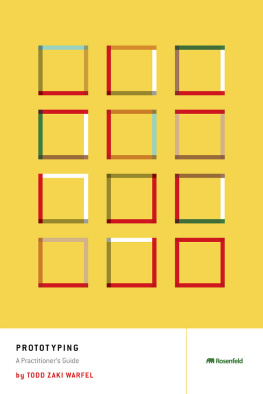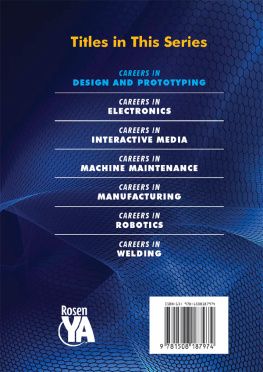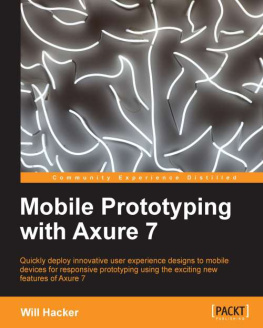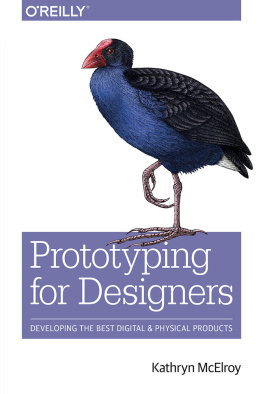Todd Zaki Warfel - Prototyping: A Practitioners Guide
Here you can read online Todd Zaki Warfel - Prototyping: A Practitioners Guide full text of the book (entire story) in english for free. Download pdf and epub, get meaning, cover and reviews about this ebook. year: 2009, publisher: Rosenfeld Media, genre: Computer. Description of the work, (preface) as well as reviews are available. Best literature library LitArk.com created for fans of good reading and offers a wide selection of genres:
Romance novel
Science fiction
Adventure
Detective
Science
History
Home and family
Prose
Art
Politics
Computer
Non-fiction
Religion
Business
Children
Humor
Choose a favorite category and find really read worthwhile books. Enjoy immersion in the world of imagination, feel the emotions of the characters or learn something new for yourself, make an fascinating discovery.
- Book:Prototyping: A Practitioners Guide
- Author:
- Publisher:Rosenfeld Media
- Genre:
- Year:2009
- Rating:4 / 5
- Favourites:Add to favourites
- Your mark:
- 80
- 1
- 2
- 3
- 4
- 5
Prototyping: A Practitioners Guide: summary, description and annotation
We offer to read an annotation, description, summary or preface (depends on what the author of the book "Prototyping: A Practitioners Guide" wrote himself). If you haven't found the necessary information about the book — write in the comments, we will try to find it.
Prototyping: A Practitioners Guide — read online for free the complete book (whole text) full work
Below is the text of the book, divided by pages. System saving the place of the last page read, allows you to conveniently read the book "Prototyping: A Practitioners Guide" online for free, without having to search again every time where you left off. Put a bookmark, and you can go to the page where you finished reading at any time.
Font size:
Interval:
Bookmark:
There are countless books on how to code HTML, CSS, and JavaScript. Theres also no shortage of software development books on how to program in Java, .Net, PHP, Python, or Ruby on Rails. Looking for a book on using Flash, Dreamweaver, Photoshop, or Visio to design interfaces? Yup, weve got those in spades, too.
What we lack is a short, yet comprehensive book focused solely on prototyping for user experience practitioners. That is until now.
This book is a mix of foundational prototyping theory and practical how-tos. Ive included a number of real-world case studies, some from my own work and some from other practitioners in the field. Ive also packed the book with a number of tips that will help you prototype faster, easier, and with greater success.
This book is written for anyone involved in the design or development of a product or service. If youre a visual designer, interaction designer, information architect, developer, usability engineer, product manager, or business owner, this book will show you how to leverage prototyping to improve communication within your company and avoid costly mistakes.
This book is organized into three main sections.
Section One. The first five chapters provide foundational theory and best practices for prototyping. Youll even find a few guidelines for selecting a prototyping method best suited for your needs.
Section Two. The next six chapters discuss specific methods of prototypingfrom paper prototyping to coded HTML. Each chapter starts with a matrix, showing how the specific method measures up, based on a number of important characteristics. Next, youll find a summary of the methods strengths and weakness. Finally, each chapter provides a step-by-step guided how-to prototyping tutorial packed with tips and tricks.
Section Three. The last chapter in the book will guide you through the actual process of testing your prototype.
This books companion Web site ( http://rosenfeldmedia.com/books/prototyping ) contains links to a number of prototyping resources, including articles, videos, tools, templates, and example files referenced in this book. You can also find a calendar of my upcoming talks on prototyping and a place to engage others in conversations about prototyping.
http://rosenfeldmedia.com/books/prototyping ) contains links to a number of prototyping resources, including articles, videos, tools, templates, and example files referenced in this book. You can also find a calendar of my upcoming talks on prototyping and a place to engage others in conversations about prototyping.
Weve also made the books diagrams, screenshots, and other illustrations available under a Creative Common license for you to download and include in your own presentations. Youll find the original illustrations and diagrams from this book at  http://www.flickr.com/photos/rosenfeldmedia/sets/ , or you can just double-click the pushpin next to the image to see them in high resolution.
http://www.flickr.com/photos/rosenfeldmedia/sets/ , or you can just double-click the pushpin next to the image to see them in high resolution.
Frequently Asked Questions
When choosing a prototyping method, a number of deciding factors need to be considered. You should start by asking the following questions: Whats the goal of this prototype? Who is its audience? How comfortable am I with this method? Is it something I already know or can learn quickly? How effective will this method be at helping me communicate or test my design? The right prototyping method for your current situation depends on how you answer these questions. As your answers change, so might your selection of prototyping methods and tools. See Chapter 5.
Neither. Prototype fidelity is a sliding scale. Dont be concerned with hi-level or lo-level fidelity. The level of fidelity that matters is whatever is needed to help you accomplish your goal with the audience for your prototype.
A prototype, regardless of its fidelity, functionality, or how it is made, captures the intent of a design and simulates multiple states of that design. Wireframes and storyboards are static representations of a design that on their own merit do not simulate multiple states of a design. Its the simulation and multiple states part that creates the distinction.
I chose to include tools that were widely used in the field of user experience. When I started this book, I surveyed a few hundred practitioners to get a feel for the most common tools being used in the field of user experience. You can find the results of that survey in Chapter 5, Picking the Right Tool.
Some tools, like Flash, have entire books dedicated to them. Flash is a great prototyping tool, but because it is so popular, I felt other tools deserved more attention.
OmniGraffle and Balsamiq are great diagramming tools that can be used for prototyping, but at the time of this book, neither represented a large enough market share to warrant writing about them. That might change. Ill be watching.
This is probably the toughest challenge faced by those who are new to prototyping. Its not that you dont want to, or that youre scared of trying and failing. Its that you cant seem to get your boss or client to see the value in prototyping.
The first chapter in this book focuses on the value of prototyping. In that chapter, youll learn how to make the argument with your client or boss that you cannot afford not to prototype. In fact, not prototyping will cost you more in the end than the time and effort it takes to prototype. Additionally, Ive included a number of case studies and insights throughout the book, which should give you additional ammunition to make the case for prototyping.
You just jump in and do it. Dont feel like you have to learn a new tool such as Fireworks or how to code HTML. Instead, start with something simpleprototype with paper or PowerPoint. You can always work your way up to something more advanced. See Chapters 611.
Whats the difference between theory and practice? Albert Einstein once said, In theory they are the same. In practice, they are not.
Practice makes perfect. Champion sports teams practice constantly. Zen masters will tell you that the only way to achieve enlightenment is practice. Practice is at the very root of learning. As you practice, you learn, and as you learn, you improve.
Prototyping is practice for people who design and make things. Its not simply another tool for your design toolkitits a design philosophy. When you prototype, you allow your design, product, or service to practice being itself. And as its maker, you learn more about your designs in this way than you ever could in any other way.
A prototype, quite simply, is different from other works of the imagination, because its real. It exists independently, outside the mind. This means that it can be testedyou can imagine various scenarios that might try to break your model, and you can design experiments that test your hypothesis.
Without a prototype, you cant test your product until you have built it, and in todays volatile business environment, where new companies can dominate markets in a few short yearsfor example, Google started in 1998, Facebook in 2004, Twitter in 2007to build a product or service before you test it is insane. Its like sending athletes onto the playing field without letting them practice beforehand. Its a recipe for failure.
So make prototypes and break them, test them and learn from them, model your ideas when they are still in their infancy, and continue to make and break them throughout the design process. Trial and error and continuous refinementthis is the way we learn as children and continue to learn as adults. And if its good enough for us, shouldnt it be good enough for our design children, our ideas, and our imagination?
Font size:
Interval:
Bookmark:
Similar books «Prototyping: A Practitioners Guide»
Look at similar books to Prototyping: A Practitioners Guide. We have selected literature similar in name and meaning in the hope of providing readers with more options to find new, interesting, not yet read works.
Discussion, reviews of the book Prototyping: A Practitioners Guide and just readers' own opinions. Leave your comments, write what you think about the work, its meaning or the main characters. Specify what exactly you liked and what you didn't like, and why you think so.













